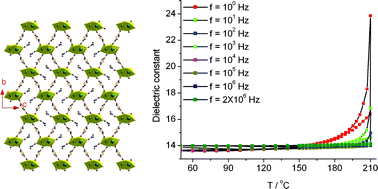A rhombus channel metal–organic framework comprised of Sr2+ and thiophene-2, 5-dicarboxylic acid exhibiting novel dielectric bistability†
Abstract
A metal–organic framework (MOF) compound, comprised of Sr2+ and

* Corresponding authors
a State Key Laboratory of Materials-Oriented Chemical Engineering and College of Science, Nanjing University of Technology, Nanjing 210009, P. R. China
b
State Key Laboratory & Coordination Chemistry Institute, School of Chemistry and Chemical Engineering, Nanjing University, Nanjing 210093, P. R. China
E-mail:
xmren@njut.edu.cn
Fax: +86-25-58139481
Tel: +86-25-58139476
A metal–organic framework (MOF) compound, comprised of Sr2+ and

 Please wait while we load your content...
Something went wrong. Try again?
Please wait while we load your content...
Something went wrong. Try again?
Q. Chen, P. Guo, S. Zhao, J. Liu and X. Ren, CrystEngComm, 2013, 15, 1264 DOI: 10.1039/C2CE26450A
To request permission to reproduce material from this article, please go to the Copyright Clearance Center request page.
If you are an author contributing to an RSC publication, you do not need to request permission provided correct acknowledgement is given.
If you are the author of this article, you do not need to request permission to reproduce figures and diagrams provided correct acknowledgement is given. If you want to reproduce the whole article in a third-party publication (excluding your thesis/dissertation for which permission is not required) please go to the Copyright Clearance Center request page.
Read more about how to correctly acknowledge RSC content.
 Fetching data from CrossRef.
Fetching data from CrossRef.
This may take some time to load.
Loading related content
